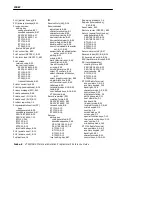
"
INDEX
VT220/ANSI Terminal Emulation Programmer’s Reference Guide
Index-3
CSI 2 l (Keyboard action,
unlocked), 8-19
CSI 4 h (Insert), 8-19
CSI 4 l (Replace), 8-19
CTRL.
See Control (special func-
tion key)
CUB (cursor backward), 8-23
CUD (cursor down), 8-23
CUF (cursor forward), 8-23
CUP (cursor position), 8-23
Cursor backward (CUB), 8-23
Cursor control key
codes generated, 8-57
local editing, 8-68
PEN*KEY 6400, 6-17
PEN*KEY 6500, 7-11
RT1100, 3-12
RT1700, 4-15
RT3210, 2-12
RT5900, 5-12
Cursor down (CUD), 8-23
Cursor forward (CUF), 8-23
Cursor key (DECCKM), 8-20
Cursor position (CUP), 8-23
Cursor positioning, 8-23
Cursor up (CUU), 8-23
Customer Response Center, 1-4
Customer Response Hotline, 1-4
CUU (cursor up), 8-23
D
DA (device attributes), 8-43
DAQ (define area qualification),
8-47
Data link escape (DLE), 8-5
Data/Talk (top-row function key)
PEN*KEY 6400, 6-20
PEN*KEY 6500, 7-14
RT1100, 3-15
RT1700, 4-18
RT3210, 2-15
RT5900, 5-15
transmitted code, 8-60
DC1 (device control 1), 8-6
DC2 (device control 2), 8-6
DC3 (device control 3), 8-6
DC4 (device control 4), 8-6
DCH (delete characters), 8-31
DCS (device control string),
8-10, 8-37
DECALN (adjustments), 8-46
DECANM (ANSI/VT52), 8-20
DECARM (auto repeat), 8-21
DECAWM (auto wrap), 8-21
DECBKM (back arrow key),
8-22
DECCKM (cursor key), 8-20
DECCOLM (column), 8-20
DECDHL (double-height line),
8-28
DECDWL (double-width line),
8-28
DECEDM (edit mode),
8-30–8-31, 8-61
DECID (identification), 8-45
Decimal values, 8-4, 8-8
DECKPAM/DECPNM (keypad),
8-22
DECNRCM (character set), 8-22
DECOM (origin), 8-21
DECPEX (print extent), 8-22
DECPFF (print form feed), 8-21
DECRC (restore cursor), 8-24
DECSC (save cursor), 8-24
DECSCA (select character
attributes), 8-27
DECSCLM (scrolling), 8-20
DECSCNM (screen), 8-21
DECSED (selective erase in
display), 8-33
DECSEL (selective erase in
line), 8-33
DECSEL/DECSED (selective
erase in line/selective erase
in display), 8-27
DECSTBM (set top and bottom
margins), 8-34
DECSTR (soft terminal reset),
8-45
DECSWL (single-width line),
8-28
DECTCEM (text cursor enable),
8-22
DECTST (tests), 8-46
DECTTC (set transmit termina-
tion character), 8-69–8-70
DECUDK (user-defined keys),
8-36, 8-44
Define area qualification (DAQ),
8-47
DEL (delete)
PEN*KEY 6400, 6-22
PEN*KEY 6500, 7-15
received code, 8-6
RT1100, 3-15
RT1700, 4-19
RT5900, 5-16
Delete
local editing key, 8-67
special function key
code generated, 8-56
encoded sequence, 9-48
PEN*KEY 6400, 6-16
PEN*KEY 6500, 7-10
RT1100, 3-11
RT1700, 4-14
RT3210, 2-11
RT5900, 5-11
terminal mode key, 8-22
terminating key, 8-54
Delete (DEL)
PEN*KEY 6400, 6-22
PEN*KEY 6500, 7-15
received code, 8-6
RT1100, 3-15
RT1700, 4-19
RT5900, 5-16
Delete characters (DCH), 8-31
Delete line (DL), 8-31
Designate characters erasable,
8-27
Designate characters non-eras-
able, 8-27
Device attributes (DA), 8-43
Device control 1 (DC1), 8-6
Device control 2 (DC2), 8-6
Device control 3 (DC3), 8-6
Device control 4 (DC4), 8-6
Summary of Contents for VT220/ANSI
Page 4: ......
Page 18: ...CONTENTS xiv VT220 ANSI Terminal Emulation Programmer s Reference Guide...
Page 26: ...SECTION 1 Introduction 1 8 VT220 ANSI Terminal Emulation Programmer s Reference Guide...
Page 264: ...APPENDIX A Bar Code Scanning A 4 VT220 ANSI Terminal Emulation Programmer s Reference Guide...
Page 276: ...INDEX Index 12 VT220 ANSI Terminal Emulation Programmer s Reference Guide...










































